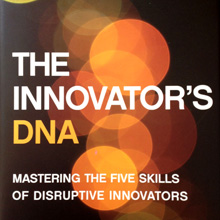#CCGInnovationTop5 – #Innovation and Disruptive Trends in #Retailing
This post is the first in a series examining disruptive influences on the horizon for different industries and product categories. Each of these potential changes will create winners and losers in the market. A good business strategy with an integrated innovation strategy, can position a company to benefit from, and even lead, the evolution in its market.
DISRUPTIVE INNOVATION & EVOLUTION IN RETAILING
The retail environment is no stranger to seismic changes, having been through many disruptive eras in the past. Examples include the disruptive impact of retail consolidation into mega-retailers (Mom & Pop stores -> Sears -> Kmart -> WalMart) and the impact of internet retailing (Amazon or eBay). Given that innovation never stops, it is interesting to look at where the next big disruptions in retailing may come from. In many of these cases, it may already be here lurking in front of us. Notably, innovative business models play as big a role as new technology in most of these cases.
1) The brand-building store – The Apple store is of course a great example of what happens when the manufacturer of a product decides that they need to be able to connect directly with the consumer. Increasingly, the powerful product brands are going to want direct connections with their consumers. There is an inherent tension between traditional retailers (who want to stock multiple product brands and emphasize both the brand of the retailer and the breadth of their product offering) and product brands (who want their brand presented to the consumer, unfiltered by the retailer). Product brands may either demand a store within a store (the Apple section at Best Buy) or create their own retail environments to get their message directly to the consumer. The stores owned by the product brands create an opportunity to offer higher levels of service because they do not have to split the margins with a third-party retailer. However, as product brands are then able to differentiate on service in their retail environments, it is reasonable to expect traditional retailers to accelerate their pace of buying or creating their own brands so that they may differentiate themselves with unique products. Retailers and product brands are going to have to evolve their relationships to deal with an environment where they may simultaneously be partners and competitors.
2) The walled ecosystem – The iTunes store is a great example of a marketplace that was created with a strict set of rules that define what may be sold and how. What is interesting is that the model relies on the retailer defining and policing the rules, but it puts a large responsibility on the company developing the product. Imagine a bricks and mortar version of this system, where a physical store is built with rules for general product assortment, merchandizing, product safety, and packaging; but where the manufacturer is then responsible for stocking the stores and managing inventory (an extension of the Frito Lay model used in grocery stores). The store would be responsible for setting rules that result in a desirable retail environment for the consumer, and for creating a unique shopping experience (driving traffic to the store). The manufacturer would be responsible for interpreting those rules and determining the best products to sell to the consumer traffic in those stores (closing the sale). This could significantly change the nature of the relationship between manufacturer and retailer.
3) The evolution of the app and the mobile device – We are already multiple generations into the evolution of mobile devices in the retail environment. As this trend continues, location barriers will cease to exist. Already, a consumer who is inside one store frequently decides to make a purchase from another one on their mobile device. This creates a question of what it means to be “inside” a retailer. That used to give the retailer a certain degree of control of the purchasing process. Now a consumer can be physically inside a store while being virtually inside another one at the same time. Retailers must consider what value they can deliver to avoid competing solely on price. Equally important will be how that value is delivered. Value delivered prior to the sale decision (i.e. product information, access to physical product samples, expertise of sales people) may not result in that consumer sticking with the same retailer to make the purchase. Value delivered after the sale (i.e. additional warranty, training, discounts on related products, or other ongoing services) may make a bigger difference in the purchase decision because it requires the consumer to go through with the purchase and not just use the physical retailer as a catalog for the virtual one.
4) Virtual reality – This is actually a very old trend in retailing in the broadest sense of virtual reality. Physical stores have had to compete with mail order, catalog, and internet companies as the virtual world evolved from black and white print, to color, to TV infomercial, to internet product demo. Each new technology made it easier for consumers to get the feel for a product without actually coming to the store to see it. However there currently remains a significant gap between the online experience and a truly great in-person retail experience (Lego store, Cabella’s, Bass World, Apple). However, we can’t assume that this will always be the case. If virtual reality gets to a point where consumers can experience a product in their home, the same way (or in better ways) than in retail, this is a significant risk to physical retail. Imagine a physical camera store competing with a virtual reality store that not only demos the camera, but allows you to try it out while standing at the rim of the Grand Canyon on a virtual vacation.
5) In-home rapid prototyping – This innovation is in its infancy when it comes to consumer use, but we are decades into its evolution in the R&D environment. The ability to quickly manufacture real parts for testing in product development, was a huge revolution when it happened. Early in my career, it was typical for this equipment to cost $500K or more. Now higher performance systems can be found for $25K or less. If this trend continues for 5, 10, or 20 more years, we may have affordable home-manufacturing systems that can be refilled with raw materials (or recycled materials) such that new items can be made at home with no need for factories, distribution systems, or physical retailers. The owners of the IP for the product design, and the manufacturers of the equipment will control the value chain in that environment. This revolution may not be far in the future. MakerBot already sells a system for under $2,000 that has some of this functionality:
http://store.makerbot.com/replicator-404.html
Chanute Consulting Group specializes in working with our clients on developing strategies for growing their businesses and increasing their innovation pipelines. Contact us to discuss how to identify potential disruptive trends that could impact your business, and use that knowledge to refine your business and innovation strategies.





